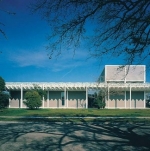Museum in light
>
Sustainability isn’t one of the specific categories recognized by the AIA in its Honor Awards program. It might as well be. Sustainable design is a theme that threads through all of the individual award categories, from interior architecture to regional design. Even the 25-Year Award acknowledges the role of sustainability in design, despite the fact that sustainability was hardly the industry buzz-word that it is today. That award, which the AIA gave to the Menil Collection by Renzo Piano, Hon. FAIA, recognizes the impact that the building has had on museum design everywhere. Yet if that building helped to spark Piano’s career, it also gave a serious boost to sustainable design, since Piano has worked at a highly visible level to promote the role of sustainability in design.
Praised by the jury as being “a monument to 20th century architecture that still resonates today,” the Menil, which opened in 1987, marks Piano’s first-ever U.S. project.
The $25 million gray-stained cypress and white-painted-steel Houston museum is laid out with the majority of the galleries and public spaces to the north of a 320-foot-long corridor, which provides a central circulation spine. The galleries were designed to allow the institution to easily rotate the display, ensuring that as many of the more than 10,000 works in the collection as possible can spend time on display.
The Menil was also one of Piano’s first explorations into maximizing indirect natural daylight in museum spaces, a technique that the AIA jury called “innovative” and noted has been “applied to other building typologies and evolved in Piano’s ongoing work.” Internal courtyards and gardens allow light to penetrate the space, and a system of curved concrete panels, which the architects termed “leaves,” over the glazed roof regulate light into the gallery spaces. These louvers extend past the building envelope to form a sheltered colonnade that shades exterior windows as well.
This exploration of natural light has, of course, became a mainstay of Piano’s museum design in the United States and abroad.
 AIA
AIA


